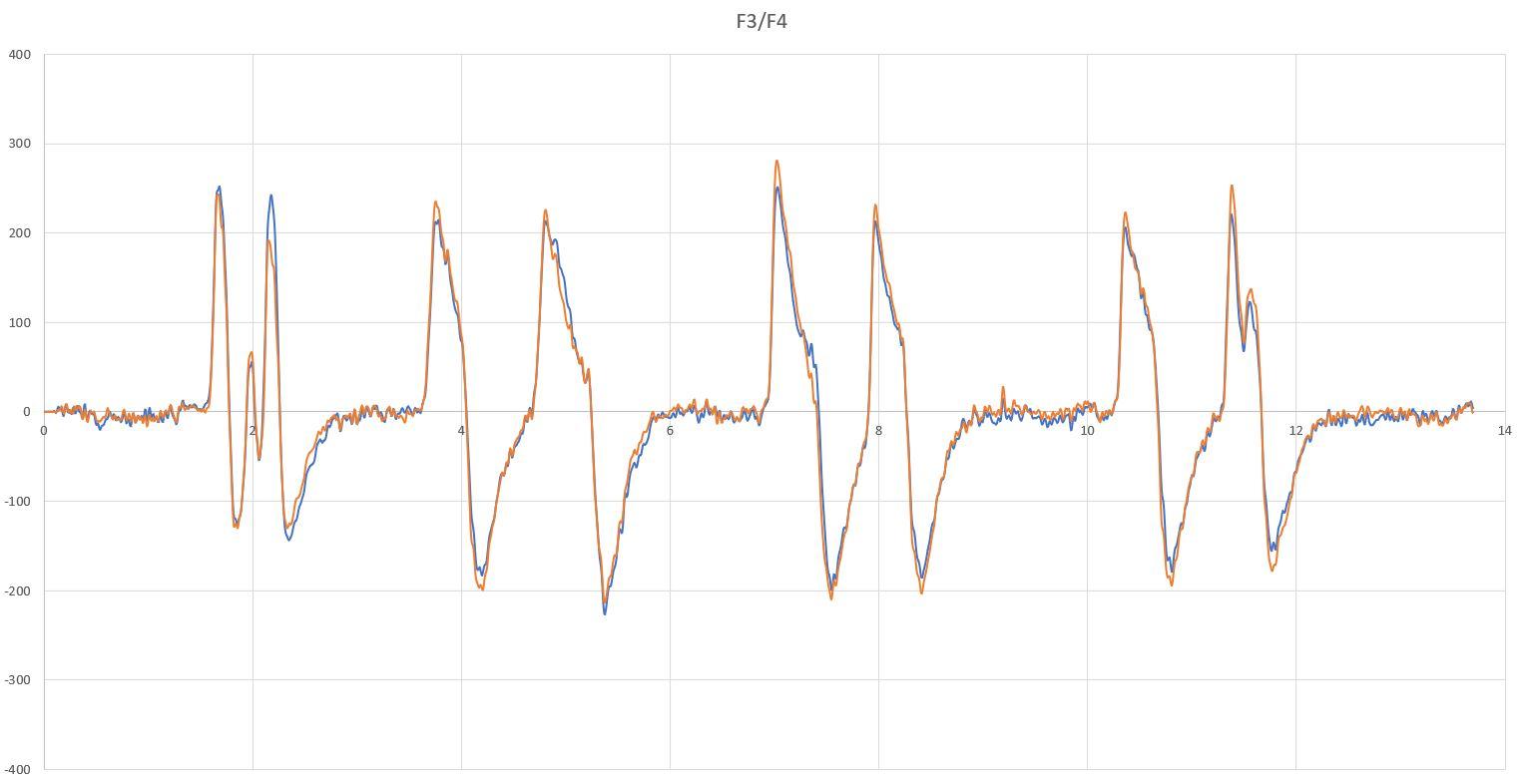新人技術者の脳波測定記~アーチファクト② 眼球運動1 瞬き編~

はじめに
脳波とは?EEGとは?何がわかるの?
そんな状況からスタートした新人技術者が実際にEEGをさわってみて感じたことを掲載する”新人技術者の脳波測定記”。
予備知識なしで挑む生の声をお伝えしようと思います。
眼球運動1:瞬き
脳活動を電気信号で捉える脳波計(EEG)にとって、観測される信号が脳活動なのか、外来信号なのか区別する必要があります。
脳波計にとって外来信号は、人体由来(感覚器からの信号や筋肉の駆動等)のものと外部由来(電源ノイズや無線信号等)のものがあります。
本章では、眼球と瞼の動きが、脳波計(EEG)の出力にどの様な影響を与えるか実際に観測し、考察していきたいと思います。
眼球と瞼の動きと言っても様々な動きがある為、今回は”瞬き”について説明致します。
瞬きとは、瞼の開閉運動のことで、1回の瞬きは平均100~150msecと言われています。
都合よく自発性まばたき(普段我々が無意識におこなう瞬き)を観測することは難しいため、今回は随意的まばたき(擬似的に瞼の開閉運動を行う瞬き)を2回1セットとして4セット行い、実施期間中に脳波計の値がどう変化するか観測※してみました。
自発性まばたきと随意的まばたきは類似信号を観測するが、自発性まばたきでは正信号と負信号の出現時間に若干の時間差があるため完全再現ではないことを事前にご理解下さい。
それでは、実験結果を見てみましょう。
※ここでは、各センサーのポジションを10-20法の電極名称を用いて記載しております。詳細に関しましては電極の配置方法をご参照下さい。
瞼の開閉運動の1セット目は間隔をあけず素早く、2セット目以降は意図的に1セット目よりゆっくり開閉を行っております。
グラフ1~6を見て頂くと分かる通り、目に最も近い前頭部(F3/F4)では脳波信号よりはるかに大きな(100倍以上)信号が瞼の開閉運動と連動して出力されていることがわかります。
また、中心部(C3/C4)、頭頂部(P3/P4)においても前頭部(F3/F4)ほどではないものの影響を受けており、距離が離れれば離れるほど影響は小さくなっていることがわかります。
なぜ、このような信号が観測されるのでしょうか。
それは、目の構造に由来します。
1.眼球の構造
網膜は静止電位の為マイナスの電荷を、その結果角膜はプラスの電荷を帯びている構造
2.瞬き時の眼球運動
眼球は眼を閉じると上を向き、目を開けると正面に向く構造
上記構造上の特性により、瞬きを行うと瞼に電気が流れ皮膚をつたって頭部に伝搬します。
本来、脳波だけを観測したい脳波計が電気信号を観測していることから、同じ電気信号である瞬きによるアーチファクトを観測してしまいます。
その影響は大きく、脳波信号の百倍以上の電圧となります。

グラフ7はF3とF4の脳波計出力を重ね合わせたものになります。
一般的に瞬きは両目が同時に開閉されるため、左右に同じタイミングで信号が発生します。
また、前述の通り、距離が離れれば離れるほど、瞬きによる信号は小さくなっる特性があり、すべての信号を見ることでこの信号が瞬きによるものか区別することが可能です。
対策/対策必須度/対策難易度
【対策】
信号の大きさ、周波数はその時々で異なる為、汎用フィルタ等で除去を試み、それでも取り除くことが難しい場合はその期間のデータを破棄する。
予備実験として、意図的に瞬きを行ってもらい、上記対応に活用する。
【対策必須度】
必須
【対策難易度】
中
無料デモンストレーション
実際に脳波を計測してみませんか?
脳波をベースにした「熟練者の技能伝承」とは?
脳波ベースにした人間の意識、判断を学習するAIとは?
不明なことが多いかと思いますので、まずは脳波を測定してどんなものか体験してみませんか?
詳細・お申込みは下記をクリックしてください。
お問い合わせ
InnerEye メーカー情報Topへ
InnerEyeメーカー情報Topページへ戻りたい方は、以下をクリックください。
免責および情報の利用
本ページは予告なく変更することがあります。
脳科学は日々新しい研究成果が発表されている分野です。
情報の正確性について万全を期しておりますが、掲載されている内容が最新の研究成果にそぐわない場合もございます。
様々な論文をご参照の上総合的にご判断下さい。
また、本ページに掲載されている内容をもとに作成されたプログラムに対して責任を負いかねますので予めご了承ください。



